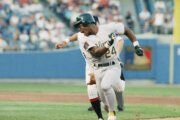WASHINGTON — He was arguably the greatest American actor of all time.
Now, we can explore Marlon Brando in his own words in the fascintating new documentary “Listen to Me Marlon” (4 stars), which opens this Friday at Landmark E Street Cinema in Downtown D.C.
Nominated for the Grand Jury Prize at Sundance, the film sorts through roughly 300 hours of never-before-heard and never-before-seen audio and video tapes recorded by Brando himself.
“It had been 10 years since Marlon had passed away, and a lot of the boxes had been in storage that entire time,” director Stevan Riley tells WTOP. “I just started questioning how interesting it would be if the story was told entirely in Marlon’s own words. … The further I got in, the more complex and contradictory he revealed himself to be.”
The documentary charts three stages of Brando’s life — his formative childhood years, his heights of Hollywood fame, and his elderly years grappling with his son’s conviction of voluntary manslaughter.
“The original concept (for the film) was a self-psychoanalysis as Brando was trying to figure out all of the whys and wherefores of his own character, and specifically how the tragedy that happened in his house … could have ever have come to pass for somebody who was so thought out and philosophical as Marlon,” Riley says. “It’s somewhat of a Freudian study too, because in order to understand how that happens, you have to go back to Marlon’s childhood. … It’s almost like your path is inescapable.”
Indeed, both Brando’s parents were drinkers who occasionally became violent.
“For somebody as sensitive as Marlon, this had massive repercussions,” Riley says. “He says we spend our entire lives trying to overcome the problems and bad habits established in the first 10 years of our lives,” Riley says. “He was really trying to correct those wrongs and in some way parent himself, and give himself the parenting he never had.”
As his life progressed, Brando dabbled in self-hypnosis and self-therapy to work out his deepest thoughts and fears. Along the way, his biggest self-help instrument was his acting ability, pioneering the Method style in Broadway shows like Tennessee Williams’ “A Streetcar Named Desire.”
“Everyone always says Brando should have done more stage acting,” Riley says. “It was just too hard for him to play Stanley Kowalski every night. … ‘Streetcar’ broke all records and was a massive, runaway Broadway success, but after two years in that, it broke him down, and the last thing he ever wanted to do was get involved in theater. I’m convinced he was an artist and really wanted to excel in his craft. As much as he would disparage acting and became very disillusioned, when he had the fire in his belly, he really wanted to do great things. I think he understood that he could reform cinema.”
‘A Streetcar Named Desire’ (1951)
Thus, he made the leap to the silver screen alongside stage-to-screen director Elia Kazan. Brando’s Method acting memorably clashed on-screen with the traditional style of Vivien Leigh, as his raw, animalistic, Oscar-nominated performance was unlike anything Hollywood had ever seen.
“He wasn’t impressed by the previous generation of actors, who he felt were far too stilted and overly dramatic, stiff in their role play. He wanted to bring in a much more manneristic, naturalistic and truthful form of acting and map the revolution with which he’s credited.”
‘On the Waterfront’ (1954)
After his breakout performance in “Streetcar” — and two more Oscar nominations for “Viva Zapata!” (1952) and “Julius Caesar” (1954) — Brando reunited with Kazan for arguably his greatest performance in “On the Waterfront,” playing washed-up boxer Terry Malloy who squandered his once promising career amid the stevedore rackets of the New York City waterfront.
The role won Brando the Oscar for Best Actor, while “On the Waterfront” won Best Picture. Ironically, Brando was anxious about his performance and surprised by the film’s success.
“He was not impressed at all with his acting and thought he could have done a much better job, and was actually very surprised when the film won an Oscar. Then he goes into a deep inquiry into ‘how did that ever come to pass? How did I think it was so bad and the audience loved it?’ So he started exploring the idea of mythology. … It’s the audience who is acting. The audience feels they could have been a contender, the audience feels inferiority … So he just felt he was a conduit for that.”
‘Guys and Dolls’ (1955)
Showing his true versatility, Brando followed the drama of “Waterfront” with the musical “Guys and Dolls,” acting across Frank Sinatra and delivering the legendary number “Luck Be a Lady.”
“That was his first really big Hollywood movie. Of course, he had already won an Oscar at that point, but that was a big-budget movie. It was a new experience for him, but in another respect, it was a respite, because he’d had a lot of very heavy roles. … A chance to act in something that was light and stretch his range as an actor. … He was already thinking about the breadth of his roles and his range, and comedy was something he really hand’t done. So he threw himself into it.”
https://www.youtube.com/watch?v=9QnbrgVu1_Q
‘Burn’ (1969)
Brando’s personal favorite performance was the lesser-known film “Burn,” directed by Italian filmmaker Gillo Pontecorvo, who had just made the masterpiece “The Battle of Algiers” (1966). The film explored British colonialism regarding the Caribbean sugar trade — a similar theme to Brando’s personal sympathy for the plight of Native Americans here in the United States.
“It’s a commentary on colonialism and greed and this quite sordid diplomacy and realpolitik that would cause men to serve themselves and get what they want at the expense of others, just the sort of thing Marlon was interested in. … He got upset that ‘Burn’ didn’t really get on anyone’s radar. It wasn’t well marketed, it didn’t go anywhere, and that was the sort of thing that left him really disillusioned. … He felt that any ‘message films’ didn’t attract the marketing bucks.”
‘The Godfather’ (1972)
Despite a fifth Oscar nomination for “Sayonara” (1957) and a stellar one-off directorial effort in “One-Eyed Jacks” (1961), the flop of “Burn” epitomized Brando’s box office struggle in the 1960s.
“He was in need of money. He had lots of dependents from different relationships and children and had an archipelago in the South Pacific to pay for. He needed work and a lot of the phones stopped ringing and a lot of the work had dried up … So there was a degree of urgency.”
With speculation that Brando’s career was in decline, director Francis Ford Coppola proved just the opposite, offering Brando a career role as mob boss Vito Corleone in “The Godfather” (1972). It would prove to be the most iconic role of his career, winning him a second Oscar for Best Actor.
“As he would often do, he would bring to bed readings and thoughts and ideas he was interested in … and one was the nature of good and evil. This was something that occupied him for other roles as well, but I think it reached its apogee in ‘The Godfather’ where he was analyzing the nature of the hero and he thought, how fascinating it would be to tell the story of a gangster, not that he was a bad man, but that he was very gentle. Just trying to get us to question our own ideas about what is good and bad, what is evil, what right do we have to judge people too quickly? That was one of his ways in.”
https://www.youtube.com/watch?v=d115-YK-9BQ
‘Last Tango in Paris’ (1972)
The same year that he played the ultimate Mafioso for Coppola, Brando also played a sultry lover in Bernardo Bertolucci’s “Last Tango in Paris.” The role earned him his seventh Oscar nomination.
“Brando appreciated the artist, the competent artist, somebody who could justify their vision,” Riley says. “Bertolucci wanted to draw this personal history out of Marlon, with Marlon being as much of himself on screen. … What better way to reveal social truths and personal truths to the audience, than to reveal your own soul? I’m pretty convinced Bertolucci managed to draw that out of him. … In that dialogue with Bertolucci, he went to places he never thought he’d go and never wanted to go.”
‘Apocalypse Now’ (1979)
He closed out the decade with another legendary turn as Colonel Kurtz in Coppola’s Vietnam War epic “Apocalypse Now,” based on Joseph Conrad’s “Heart of Darkness.” The ambitious project ballooned into a notoriously hellacious shoot, but left film history with an undoubted masterpiece.
“There was an article in Life magazine where Coppola had talked in disparaging terms about Brando’s commitment to the role, that he was time wasting, that he arrived on set and he was overweight, and Brando didn’t appreciate that,” Riley says. “He got very upset by that, because he thought he had saved Coppola in the course of making that film, because the script wasn’t fully formed and it was rewritten by Brando. … (Brando) should definitely be given a lot of credit for reforming that last act, and he thought it was a major betrayal by Coppola for not recognizing that.”
That final act is the stuff of movie legend, with Brando lurking with half-lit faces and speaking existential monologues that built to the legendary line, “The horror. The horror.”
“There was something a bit didactic and teacher-like, lecturing. He wanted to make sure we understood these things. There was a purpose in that. Rather than just indulging in his own negativity, he was trying to communicate things for the audience to digest.”
‘Listen to Me Marlon’ opens Friday at E Street Cinema. Click here for ticket information.
Listen to the full interview with director Stevan Riley below.
★ ★ ★ ★
The above rating is based on a 4-star scale. See where this film ranks in Jason’s Fraley Film Guide. Follow WTOP Film Critic Jason Fraley on Twitter @JFrayWTOP.








